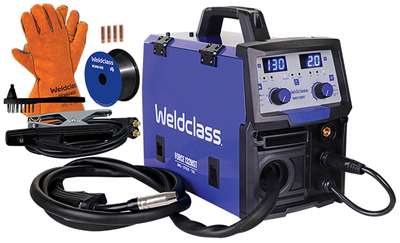The Importance of a Respirator Welding Helmet and Gasless MIG Wire for Safe and Efficient Welding
Welding is a highly skilled and intricate process that requires both expertise and the right equipment to ensure quality results. Whether you're a seasoned professional or a DIY enthusiast, having the proper tools not only enhances the outcome but also safeguards your health. Two essential elements that every welder should consider are a respirator welding helmet and gasless MIG wire. These tools help improve the safety, comfort, and efficiency of the welding process, allowing for a better working environment and more consistent results.

This article will explore the vital role a respirator welding helmet plays in protecting welders from harmful fumes and debris while working, and why gasless MIG wire is an excellent choice for specific welding tasks.
The Role of a Respirator Welding Helmet in Ensuring Safety
A respirator welding helmet is a crucial piece of personal protective equipment (PPE) for any welder. Traditional welding helmets protect the eyes and face from sparks, UV radiation, and intense light produced during the welding process. However, these helmets do not offer protection from harmful airborne particles and fumes that are a byproduct of welding.

When a welder melts metal during the welding process, it releases toxic fumes and gases, including ozone, nitrogen oxides, and carbon monoxide. Prolonged exposure to these substances can lead to serious health issues, including respiratory problems and lung disease. A respirator welding helmet combines a standard welding helmet with a built-in respirator that filters out hazardous particles, providing additional protection for the welder’s lungs and respiratory system.
1. Protection from Toxic Fumes
One of the primary advantages of a respirator welding helmet is its ability to protect against the inhalation of toxic fumes. Depending on the material being welded, the fumes released can contain dangerous substances like cadmium, lead, or zinc. These substances can be harmful if inhaled over long periods, leading to both short-term and long-term health complications.
By integrating a respirator into the welding helmet, the wearer is equipped with an efficient filtration system that removes harmful particles from the air, ensuring that the welder is breathing cleaner air while working. This feature is especially important for welders who work in confined spaces or poorly ventilated environments, where fumes can accumulate quickly.
2. Enhanced Comfort and Convenience
A respirator welding helmet also enhances comfort by allowing welders to focus on the task at hand without being distracted by the need to constantly adjust or remove a separate respirator mask. With a built-in respirator, welders can enjoy the convenience of having both eye protection and respiratory protection in one piece of gear. This reduces the overall weight and bulk of the equipment and ensures that it stays securely in place during the welding process.
3. Compliance with Safety Standards
Many welding environments, especially industrial settings, have strict health and safety regulations regarding the exposure to welding fumes. Using a respirator welding helmet helps ensure that welders are compliant with these safety standards, reducing the risk of workplace accidents and ensuring the welder’s health is prioritized.
Why Choose Gasless MIG Wire?
MIG (Metal Inert Gas) welding is one of the most commonly used techniques in the welding industry due to its ease of use and versatility. Traditionally, MIG welding requires the use of shielding gas, such as argon or carbon dioxide, to protect the weld pool from contaminants in the air. However, gasless MIG wire offers a distinct advantage for certain welding applications, making it an increasingly popular choice among welders.
Gasless MIG wire is a type of flux-cored wire that does not require an external gas supply. It contains a flux core that releases gases when heated, creating its own shielding gas to protect the weld pool. This makes it an ideal choice for welding in outdoor or windy conditions, where the use of traditional shielding gas may be ineffective.
1. Versatility in Various Environments
One of the primary advantages of gasless MIG wire is its versatility. In environments where shielding gas would be blown away by the wind or in areas without access to gas cylinders, gasless MIG wire allows for a more reliable welding process. This is particularly useful for outdoor projects, such as welding on construction sites or automotive repairs, where environmental factors may hinder the use of traditional MIG welding methods.
By eliminating the need for external gas, gasless MIG wire provides welders with more flexibility, enabling them to work in a variety of settings without compromising the quality of the weld.
2. Cost-Effective Option
Another significant benefit of gasless MIG wire is its cost-effectiveness. Traditional MIG welding requires the purchase of shielding gas, which can become expensive over time, especially for larger or ongoing projects. Gasless MIG wire eliminates this cost, making it a more economical option for welders on a budget.
The absence of gas cylinders also reduces the complexity of the welding setup, making it easier for beginners or DIY enthusiasts to get started without investing in additional equipment. This makes gasless MIG wire a popular choice for home welders and hobbyists.
3. Easier to Use for Beginners
For those new to welding, gasless MIG wire can be an easier option to work with. The process is more straightforward since it eliminates the need to manage a separate gas tank, regulator, and hoses. Beginners can focus solely on the technique and the quality of the weld without worrying about gas flow adjustments or the risk of running out of gas mid-project.
Moreover, gasless MIG wire is less sensitive to changes in atmospheric conditions, making it more forgiving for welders who are still perfecting their skills. This user-friendly aspect has contributed to the growing popularity of gasless MIG wire among novice welders.
How Respirator Welding Helmet and Gasless MIG Wire Work Together
Both the respirator welding helmet and gasless MIG wire contribute to a safer and more efficient welding experience, but they address different aspects of the welding process. While the respirator welding helmet primarily protects the welder from harmful fumes and particles, gasless MIG wire ensures that the weld is properly shielded without the need for external gases.
By combining the two, welders can achieve both superior safety and improved productivity. The respirator welding helmet keeps the welder’s respiratory system protected, while the gasless MIG wire eliminates the need for shielding gas, making the welding process faster and more convenient, especially in environments where traditional methods might fall short.
Conclusion
Welding can be a hazardous activity if proper safety measures are not taken. A respirator welding helmet provides essential protection against harmful fumes and particles, while gasless MIG wire offers a more flexible and cost-effective solution for certain welding applications. Together, these tools help ensure that welders can work more efficiently and safely, whether they’re working indoors, outdoors, or in challenging environments. By investing in high-quality equipment like a respirator welding helmet and gasless MIG wire, welders can ensure better results and reduce the risks associated with the welding process.
What's Your Reaction?
 Like
0
Like
0
 Dislike
0
Dislike
0
 Love
0
Love
0
 Funny
0
Funny
0
 Angry
0
Angry
0
 Sad
0
Sad
0
 Wow
0
Wow
0






















































